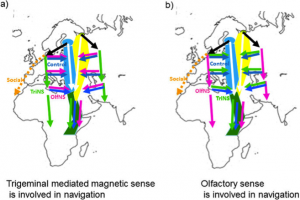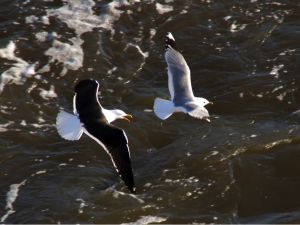Migratory birds fly over thousands of kilometers in order to visit breeding or non-breeding grounds every year. Once migrator birds become experienced adults, they develop the ability of true navigation. True navigation consists of picking up cues in unfamiliar areas to correct navigational displacement along a migration. One long-distance migratory bird that uses true navigation is the Lesser Black-backed Gull (Larus fuscus fuscus), which migrates from northern Europe to the great Lake Victoria region in Africa.

Olfactory sense is important for Gulls to reach their population-specific migration corridor http://www.nature.com/articles/srep17061
There are competing theories for how birds orient themselves during long migratory journeys without straying off course. One theory is that birds use olfactory cues, whereas others suggest magnetic field intensity cues. A study conducted by Wikelski et al. (2015) investigated the roles of different sensory systems in Black-backed Gull navigation. They used sensory manipulations to isolate which cues help birds compensate for displacement and return to their original course. In order to isolate whether olfactory cues or magnetic field cues are necessary for navigation, Wikelski et al. (2015) sectioned either olfactory nerves or the ophthalmic branch of the trigeminal nerve, which has been implicated in magnetic field cues. The researchers also translocated birds either westward or eastward to simulate navigation challenges. Their hypothesis was that gulls that could not use proper sensory cues for migration would continue to migrate southward, whereas gulls that could use the necessary cues would migrate to their population-specific migration corridor.
The results showed that birds with olfactory nerves sectioned could not compensate for the translocation, but still had a clear directional preference for migrating south. These birds could not correct longitudinal displacements, which suggests that they may need air-borne olfactory information for such navigation challenges. In contrast, intact birds and birds with the ophthalmic nerve sectioned still oriented towards their population-specific migratory corridor. This further suggests that magnetic field intensity cues may not be vital for navigation and that olfactory cues play a larger role. However, when Wikelski et al. (2015) displaced birds within southeast Russia, the olfactory nerve-sectioned birds were able to correct for the displacement. This could have been because these birds were familiar with the location to which they were displaced. If this speculation is true, it suggests that olfactory cues are necessary for displacement navigation in unfamiliar territory. Birds that are not displaced outside of their migratory corridor or familiar territory may rely on other cues such as magnetic field intensity or visual cues to navigate.
The study has broader implications for how researchers and the larger scientific community understand avian migration. Although it is widely accepted that long-distance migratory birds use magnetic field intensity to gauge where they should go, Wikelski et al. (2015) report that this may not paint an accurate picture of avian navigation. Data from the Black-backed Gull elucidates the importance of olfactory cues for migration in birds and may implicate spatial navigation in other animals as well.

